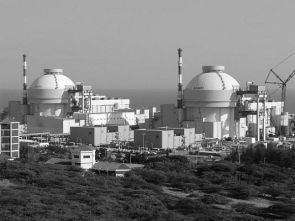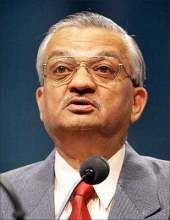'There has definitely been a breakthrough in the nuclear logjam. It is good to see nuclear energy back on the rails,' says Dr Anil Kakodkar, former chairman, Atomic Energy Commission.

Dr Anil Kakodkar, former chairman of India's Atomic Energy Commission, played a key role during Manmohan Singh's tenure as prime minister towards the purchase of nuclear fuel and technology.
He continues to play an important behind-the-scenes role as consultant and negotiator in this key area.
Dr Kakodkar, left, below, spoke to Rediff contributor Rashme Sehgal.
India and the US have achieved a major breakthrough in the nuclear logjam. This was a major outcome of President Obama's visit.
There has definitely been a breakthrough in the nuclear logjam. The understanding was already there, but it is good to see that nuclear (energy) is back on the rails.
What implication will this have especially when the government has clarified that plant operators will bear the primary liability?
The US laws on this subject are quite complex. We needed to understand things from their perspective.
The language of our liability act (the Civil Liability for Nuclear Damage Act) was a problem. The civil liability act had to be explained properly to them (the US).
What exactly does this mean?
According to the Indian liability act, the right of recourse, whereby Americans, and other vendors -- and this includes Indian industry which are also supplying nuclear equipment -- had been arguing that there should be a changing of the liability clause so that the operator bears the brunt of the liability unless they find an intent by the supplier to cause damage or he provides defective parts.
What is termed as a malevolent act by the suppliers?
We will have to read what it means in the overall framework of the agreement because the provision has to be read along with the context of the relevant clause in the contract between the operator and supplier on product liability which both parties can work out.
Is the Indian liability law incompatible with international standards?
There can be no debate over the operators's liability but to translate it to a supplier several years after the delivery has been made will affect them.
There is no argument against taking insurance and paying a small premium against liability.
Is it correct that India will set up an insurance pool with a liability cap of Rs 15 billion? The premium for this will be paid by the Nuclear Power Corporation of India?
The Nuclear Power Corporation of India will set up an initial pool of Rs 1,500 crore (Rs 15 billion). But NPCIL, which is a public sector company, as a matter of policy, in their nuclear supply contracts contain provisions for a right to recourse which is consistent with the civil liability act.
I must explain that new products are being designed. These liabilities will get larger, but will not be on the supplier. Rather, they will fall on the operators.
But in order to meet these larger liabilities, companies (in the US) all pool together their resources.
If we want to produce 100,000 MWs of power that is a huge amount. Companies would have to pool their money.
India did not begin its programme in such a large manner; rather it began very small.
There is question mark about nuclear energy. We have been witness to the disaster at Fukushima.
The deaths in Fukushima were not caused because of radiation. The deaths were caused by the tsunami and in the reactor were caused because of flooding.
Radiation release at Fukushima has been negligible. What we were witnessing there was a disaster syndrome and nobody wants that.
The accident should not have happened. All said and done, the Japanese government shut down all the nuclear plants and reviewed their nuclear policy. But they are presently bringing their reactors back to operation.
The reactor designers have been improved following the Fukushima accident. The diesel power supplier got damaged there, but now it has been located in an elevated place where flooding cannot take place.

There is a question being raised on the rising costs of nuclear power. It is an extremely expensive form of energy?
No, nuclear energy is not very expensive. There is no one cost structure for this energy. Indians have become experts at doing different high tech jobs at half the cost of other nations.
This contribution is not restricted to nuclear alone, but to a whole variety of high tech jobs.
We make domestic reactors within the country and our per megawatt cost of a reactor is much less than what is being charged by Western companies.
We can build equipment and make arrangement with Indian manufactures to produce nuclear components. Value addition is done here and not in several other countries.
The cost of nuclear energy compares well with other forms of energy.
NPCIL gets a lot of hidden subsidies which are never shown in their account books.
Let me clarify that NPCIL receives no subsidies. It is a public sector company and it pays for everything. Its accounts are audited according to company law.
We must not forget that in the long run, our requirement is based on our per capita energy use.
At present, our per capita use is 14 times smaller than that of advanced countries, but once we enhance our standard of living and achieve greater parity on the human development index, our energy consumption will go up 8 to 9 times.
There is a strong case for renewable energy and several experts believe that is where the thrust should be.
Every country needs an energy mix. Both nuclear and solar energy will be big enough to last for a long time. Between solar and nuclear, there is a lot of diversity.
But we cannot forget that nuclear reactors generate energy 24 x 7. Solar is a distributed source of energy. In order to generate 100 megawatts of energy, we will have to collect it from over a large area.
We need to have both, though there are differences between them. We cannot do without nuclear. Hydro and wind are other non-renewable sources.
We say we have enough coal reserves to last 100 years but after that our coal will be finished. That is why an indigenous nuclear programme deserves first priority.
What about switching over to thorium given that we do not have much uranium?
Our uranium reserves are modest. If we can access uranium, then we can accelerate our programme. We have a three stage nuclear programme and thorium will be introduced in the third stage.
Would you agree that India has lost over five years in generating nuclear energy?
Yes, we have lost 5 to 6 crucial years. It should not have happened. What we are doing now should have happened six years ago.
Should India have ratified the Convention on Supplementary Components?
Yes, it should have happened. I do not know what is the delay. It should be done quickly.
Land acquisition for nuclear projects has seen major protests on the ground.
Land acquisition is an issue for all big projects. The issues to be asked is whether the compensation being offered is adequate and that rehabilitation must also be done properly. There is a human angle to this.
Jaitapur in Maharashtra witnessed protests.
The land in Jaitapur has been acquired. These days the package is much better. This will remain an issue.
We have witnessed huge protests in both Jaitapur and Kudankulam.
Any power plant requires water. For any energy conversion process, there has to be a heat sink, provided either with water or air. Water can absorb more heat and that is why nuclear plants are located near water bodies.
People have genuine apprehensions. Fishermen say their catch will go down, but in Japan the opposite is known to have happened. Due to the warm water being discharged, the fish supply had increased.
When they closed the reactor for annual maintenance, the fish production actually went down.
Of course, there is an issue of large scale displacement of people.
The disposal of nuclear waste is also a huge problem.
In the US, they follow the principle of open fuel cycle, where they take out the waste and keep it in storage to be entrusted in a repository.
In India, we follow the closed fuel cycle approach where we recycle it and we are doing that for around 98 per cent of our uranium and plutonium.
So, around two to five per cent of quantity becomes waste. France is known to recycle its entire fuel.
The technology of small glass matrix helps to immobilise the waste. The removal of cesium is critical for waste treatment. But we are working towards reducing radioactivity.
We believe a solution for reducing radioactivity of waste is around the corner. With thorium, the waste problem may vanish.
In the third stage of our nuclear development, we hope to introduce thorium to help maintain capacity. And we believe the PHWR fast breeders will be able to meet India's energy requirement for the next 200 years.
What kind of investment flow do you see flowing in with the ironing out of the differences over the liability clause?
The country hopes to build up 60,000 MWs between now and 2030, 2032. We are hoping to increase our nuclear capacity to around 10,000 MW and for that I expect Rs 500,000 crores (Rs 5 trillion) to come in. It has a (strong) business case.
Even as the capital cost use is more expensive, the tariff will be competitive. Once the investment has come, then the capacity has to grow.
Considering the increasing presence of terrorism in Southeast Asia, the proliferation of nuclear plants can have a dangerous repercussion.
It is a dangerous neighbourhood. We are living in an area that is disturbed, but electricity is an important input for development and is needed for peace and stability.











 © 2025
© 2025